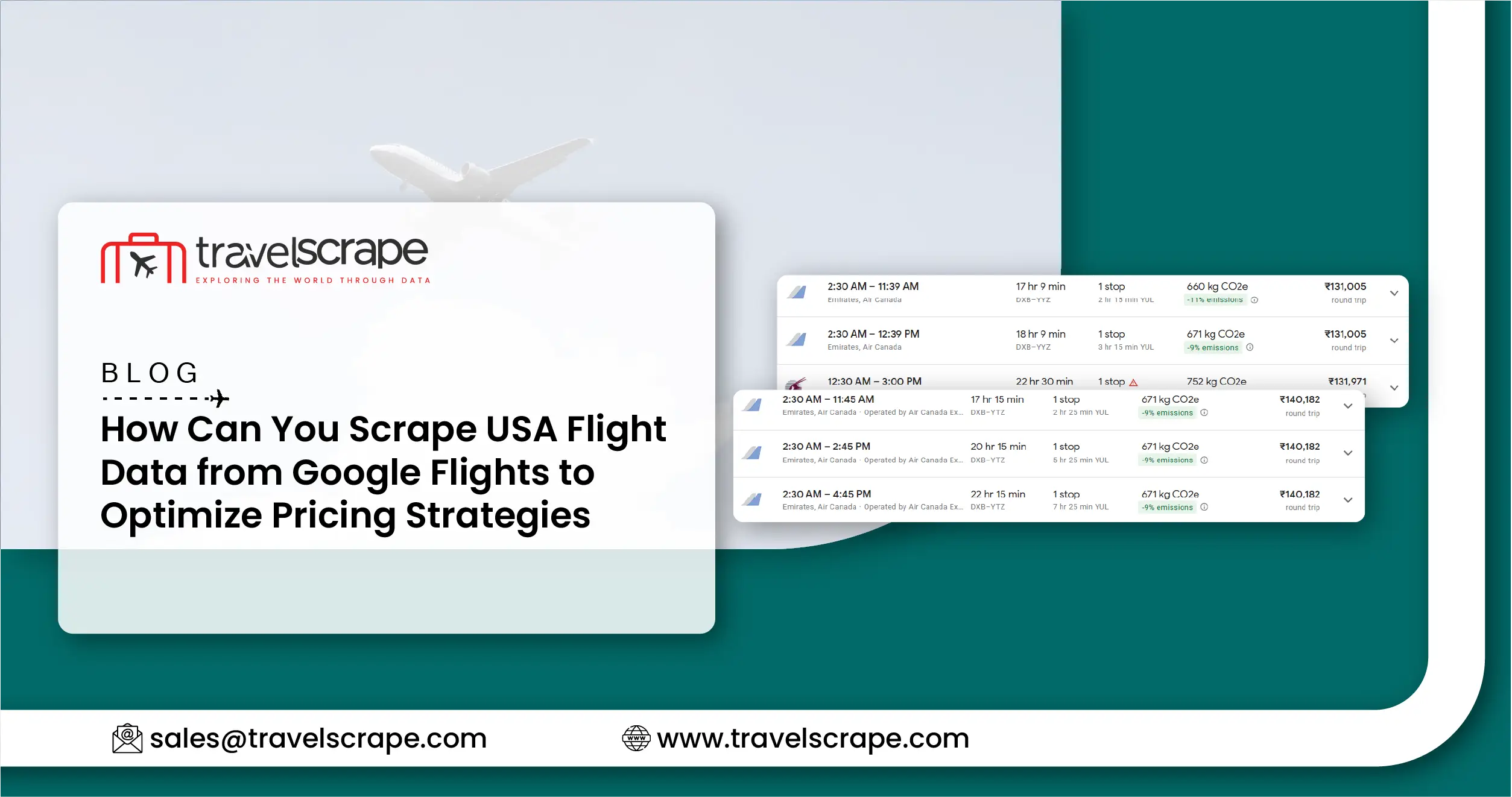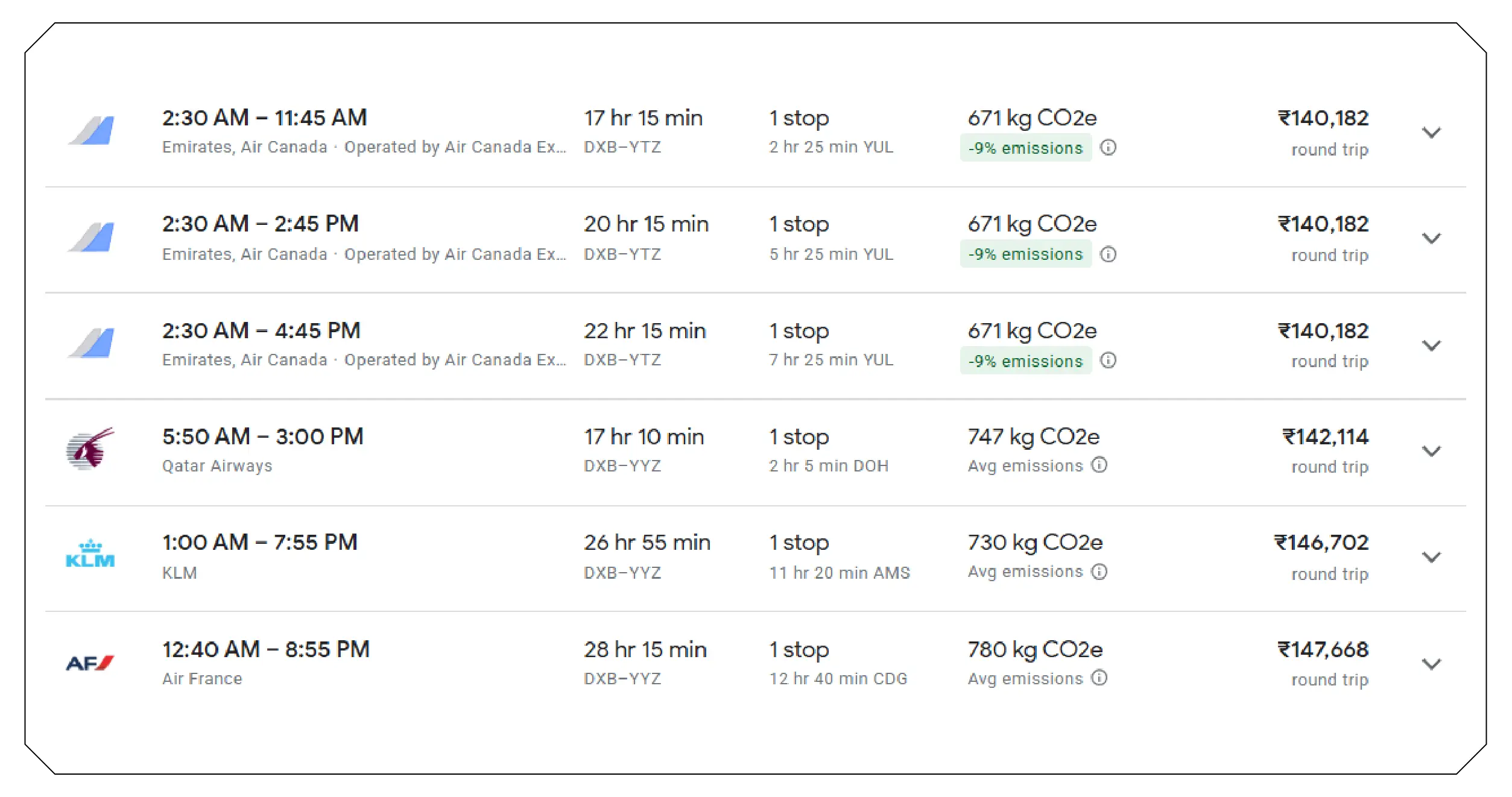How Can You Scrape USA Flight Data from Google Flights to Optimize Pricing Strategies?

Introduction
The airline industry in the United States has become one of the most dynamic and competitive sectors, where ticket prices fluctuate frequently based on demand, seasonality, and competitor strategies. For businesses, travel agencies, and data-driven analysts, the ability to Scrape USA Flight Data from Google Flights opens doors to unmatched opportunities for tracking market trends, monitoring competitor pricing, and building predictive models for decision-making. Google Flights has become a preferred search engine for travelers, offering price transparency, route availability, and booking insights across thousands of airlines and destinations. By creating structured datasets from this rich information source, businesses can transform fragmented pricing data into actionable intelligence.
At the heart of this process lies the ability to collect a Google Flights Global Flight Prices Dataset , which allows stakeholders to view airfare variations in real-time, understand seasonal demand, and design strategies to optimize travel packages. Whether it’s monitoring domestic routes within the U.S. or comparing long-haul international flights, such datasets enable unparalleled insights into how pricing fluctuates across carriers and booking windows. With advanced scraping techniques, organizations can now Extract USA flight pricing using Google Flights, gaining visibility into route-specific fares, price alerts, and carrier promotions. This structured data can then be integrated into custom dashboards or analytical tools, helping businesses understand airfare trends, react to competitor changes, and offer travelers the most affordable options available.
Why Google Flights Data Matters?

Google Flights aggregates data from hundreds of airlines and travel partners, making it one of the most reliable platforms for real-time fare comparison. Unlike static pricing on some booking portals, Google Flights updates continuously, reflecting changes in availability, discounts, or demand spikes. By choosing to Extract Google Flights Flight Price Data , businesses can capture these micro-adjustments and feed them into forecasting models.
The benefits extend beyond pricing transparency. For instance, travel agencies can design more competitive packages, airlines can monitor competitor routes, and consumers can benefit from optimized booking suggestions. The capacity to aggregate this data across thousands of searches creates opportunities for predictive analytics, particularly for peak travel periods such as holidays, conferences, and summer vacations.
Applications of Google Flights Scraping
Applications of Google Flights Scraping extend far beyond price tracking, empowering businesses to optimize revenue, benchmark competitors, and anticipate seasonal demand. By extracting real-time airfare data, schedules, and availability, travel agencies, airlines, and analysts can design dynamic strategies, improve customer offerings, and unlock actionable insights. This approach transforms raw flight data into powerful intelligence for the travel industry.
-
Pricing Strategy and Revenue Optimization:
Airlines constantly adjust fares based on load factors, competitor pricing, and seasonal trends. By adopting Real-time flight data scraping Google Flights USA, pricing analysts can evaluate fare fluctuations hour by hour, ensuring that ticket costs remain competitive. This allows both travel businesses and airlines to dynamically respond to customer demand while maximizing profitability. -
Market Benchmarking and Competitor Analysis:
Travel agencies and aggregators need to stay updated on competitor offerings. Scraping helps them monitor pricing strategies, promotional campaigns, and ancillary services across different airlines. This benchmarking ensures that customers are provided with the most attractive deals available in the marketplace. -
Forecasting and Demand Planning:
Flight pricing isn’t just about numbers—it reflects traveler sentiment and seasonal behavior. By collecting a Google Flights Flight Schedules Dataset , stakeholders can analyze which routes are filling up quickly, anticipate surges in demand, and adjust operations accordingly. For example, airlines might increase flights on high-demand routes while reducing capacity on underperforming ones. -
Availability and Inventory Tracking:
For online travel agencies, the ability to know when specific routes or fare classes are available is critical. Through Scraping Google Flights for USA flight availability, businesses can ensure that their booking platforms are aligned with the most current information, reducing the risk of showing outdated or unavailable options. -
Long-Term Price Analysis:
Short-term fluctuations are valuable, but long-term historical data is even more powerful. Collecting a Google Flights Price Trends Dataset enables businesses to evaluate how fares shift over months or years, helping to build predictive models that accurately forecast future ticket prices.
Technical Approach to Scraping Google Flights
Scraping Google Flights requires sophisticated methods due to its dynamic structure and continuous updates. Unlike static web pages, flight information changes in real-time, requiring scrapers to adapt quickly. Below are some common strategies:
-
Headless Browsers and Automation Tools:
Tools like Puppeteer or Selenium can simulate user interactions, allowing scrapers to capture flight data dynamically rendered on Google Flights. -
Proxies and Rotating IPs:
To avoid request blocking, scrapers rely on proxy servers and IP rotation, ensuring continuous data extraction without interruptions. -
Parsing JSON APIs (where available):
In some cases, flight data is delivered through JSON APIs embedded in network calls. Scrapers can intercept and parse these requests to extract structured data efficiently. -
Data Structuring and Storage:
Collected data must be normalized into structured formats like CSV, JSON, or databases. This is crucial for transforming raw data into analytical insights.
Business Use Cases of Google Flights Data
Business use cases of Google Flights data highlight its value for airlines, travel agencies, tourism boards, and consumer platforms. By leveraging structured flight pricing, availability, and booking trends, organizations can optimize revenue strategies, improve market competitiveness, and deliver personalized travel experiences. This actionable intelligence enables smarter decision-making across the entire travel and hospitality ecosystem.
Travel Agencies:
Agencies thrive by offering competitive deals. Through Google Flights USA booking
trends scraping, agencies can understand traveler booking windows, peak times, and
popular routes. This ensures they can create packages that align with demand.
Airlines:
Airlines benefit by monitoring competitors, adjusting fares, and identifying
underserved routes. For instance, if a competitor launches a discount on a
high-demand route, scraping ensures an airline can respond almost instantly with
counter offers.
Tourism Boards and Hospitality Industry:
Tourism boards can analyze inbound traveler patterns, while hotels can align room
rates with peak flight arrival dates. This integration strengthens tourism and
hospitality strategies.
Consumers and Apps:
For consumer-facing applications, scraped data can power alert systems that notify
users when fares drop. Travel startups can innovate around this by providing
real-time push notifications and predictive insights.
Challenges in Scraping Google Flights
- Dynamic Rendering – Google Flights uses dynamic rendering, requiring scrapers to simulate real-time user sessions.
- Rate Limiting – Excessive requests may trigger blocks, necessitating proxy networks and request throttling.
- Data Volume – The sheer scale of searches generates massive datasets, requiring scalable infrastructure.
- Legal and Ethical Considerations – Scraping must comply with regulations and respect the platform's terms of use.
Despite these challenges, businesses using responsible and ethical scraping approaches can achieve immense benefits.
Future of Flight Data Intelligence

The travel industry is undergoing a rapid transformation as data-driven strategies become central to competitiveness. With the growing reliance on technology, scraping tools are playing a crucial role in providing airlines, agencies, and analysts with structured and timely flight datasets. These datasets offer a foundation for building powerful machine learning models capable of predicting airfare fluctuations, traveler booking behavior, seasonal demand spikes, and even route profitability with remarkable precision. As automation advances, the ability to integrate scraped data directly into predictive analytics platforms will accelerate decision-making processes across the industry. This integration ensures that pricing strategies, route planning, and promotional campaigns are optimized in real time, keeping businesses agile in an ever-changing market. Ultimately, scraping combined with advanced analytics represents the future of smarter, faster, and more profitable operations in the highly competitive travel ecosystem.
How Travel Scrape Can Help You?
-
Custom Data Extraction:
We build tailored solutions to scrape flight pricing, availability, and route information from platforms like Google Flights, ensuring data accuracy and completeness. -
Real-Time Monitoring:
Our scraping systems track fare fluctuations, seat availability, and competitor offers in real time, empowering smarter pricing and booking strategies. -
Structured Datasets:
We deliver clean, organized datasets in formats like CSV, JSON, or API feeds, making them ready for integration into your analytics or dashboards. -
Scalable Solutions:
Whether you need daily updates for a few routes or comprehensive coverage of global flights, our systems scale effortlessly to match your requirements. -
Actionable Insights:
Beyond data delivery, we enable predictive trend analysis and visualization, helping businesses optimize revenue, forecast demand, and improve customer experiences.
Conclusion
The ability to scrape and analyze Google Flights data has transformed how airlines, agencies, and analysts approach travel pricing and planning. By integrating structured datasets into predictive systems, businesses gain clarity over fluctuating fares, route availability, and consumer behaviors.
In practice, the capacity to Web Scraping Google Flights USA routes ensures comprehensive visibility into domestic and international connectivity. At the same time, adopting methods for Scraping Google Flights for USA flight deals empowers businesses to offer the most competitive packages to travelers. Finally, leveraging Flight Price Data Intelligence consolidates raw flight data into strategic insights, shaping the future of decision-making in the U.S. travel sector.
Ready to elevate your travel business with cutting-edge data insights? Scrape Aggregated Travel Deals to identify competitive rates and optimize your revenue strategies efficiently. Discover emerging opportunities with tools to Scrape Travel Website Data, leveraging comprehensive data to forecast market shifts and enhance your service offerings. Scrape Travel Mobile App to stay ahead of competitors, gaining instant insights into bookings, promotions, and customer behavior across multiple platforms. Get in touch with Travel Scrape today to explore how our end-to-end data solutions can uncover new revenue streams, enhance your offerings, and strengthen your competitive edge in the travel market.

